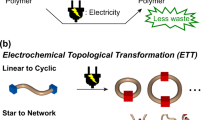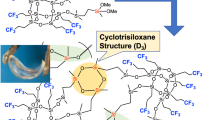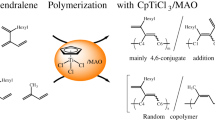Abstract
α-(3-(1-Pyridinio)-propyl)-polydimethylsiloxane iodide (PDMS-Py+I−) and α-(3-(N,N-dimethylethylammonio)-propyl)polydimethylsiloxane iodide (PDMS-Am+I−) were prepared from PDMS containing iodopropyl group at the chain end. The prepolymer was synthesized by a ring-opening polymerization of hexamethylcyclotrisiloxane (D3) initiated with lithium trimethylsilanolate followed by the termination with 3-chloropropyldimethylchlorosilane and the halogen substitution with sodium iodide. All the polymers effectively enhanced the drug penetration through the skin and the permeation coefficients were about 2–6 times as much as that without enhancer. It was revealed from the detailed analysis of the permeation profile that the permeation and partition coefficients increased in parallel, with increasing of the average degree of polymerization, while the diffusion coefficients were unchanged.
Similar content being viewed by others
Log in or create a free account to read this content
Gain free access to this article, as well as selected content from this journal and more on nature.com
or
References
Part I; T. Aoyagi, Y. Takamura, T. Nakamura, Y. Yabuchi, and Y. Nagase, Polymer, in press.
Part II; T. Aoyagi, T. Nakamura, and Y. Nagase, Polym. J., 24, 375 (1992).
D. L. Bissett, “Transdermal Delivery of Drugs,” Vol. I, CRC Press, Boca Raton, FL, 1987, p 29.
R. Woodford and B. W. Barry, J. Toxicol. Cutaneous Ocul. Toxicol., 5, 167 (1986).
H. Okabe, K. Takayama, A. Ogura, and T. Nagai, Drug Design and Delivery, 4, 313 (1989).
K. Takayama, H. Okabe, Y. Obata, and T. Nagai, Int. J. Pharm., 61, 225 (1990).
R. Kadir and B. W. Barry, Int. J. Pharm., 70, 87 (1991).
O. Wong, J. Huntington, R. Konishi, J. H. Rytting, and T. Higuchi, J. Pharm. Sci., 77, 967 (1988).
O. Wong, N. Tsuzuki, B. Ngheim, J. Kuehnhoff, T. Itoh, K. Masaki, J. Huntington, R. Konishi, J. H. Rytting, and T. Higuchi, Int. J. Pharm., 52, 191 (1989).
T. Aoyagi, O. Terashima, N. Suzuki, K. Matsui, and Y. Nagase, J. Controlled Release, 13, 63 (1990).
T. Aoyagi, O. Terashima, Y. Nagase, and K. Matsui, Polymer, 32, 2106 (1991).
I. A. Boyd and C. L. Pathok, Scot. Med. J., 9, 345 (1964).
W. R. Pfiister, R. P. Sweet, P. A. Walters, and D. J. Sandvig, “Proceeding of the 13th International Symposium on Controlled Release of Bioactive Materials,” Vol. 13, Controlled Release Society, Inc., Deerfield, IL., 1986, p 220.
G. F. Needham and J. F. Waqgner, “Proceedings of the 16th International Symposium on Controlled Release of Bioactive Materials,” Vol. 16, Controlled Release Society, Inc., Deerfield, IL., 1989, p 257.
Y. W. Chien, Te-yen Chien, R. E. Bagdon, Y. C. Huang and R. H. Bierman, Pharm. Res., 6, 1000 (1989).
K. L. Uiman and Chi-Long Lee, J. Controlled Release, 10, 2739 (1989).
T. Aoyagi, Y. Takamura, T. Nakamura, and Y. Nagase, Polymer, in press.
T. Aoyagi, M. Yamamura, K. Matsui, and Y. Nagase, Drug Design and Discovery, 8, 47 (1991).
T. Higuchi, J. Soc. Cosmetic Chemists, 11, 85 (1960).
R. J. Scheuplein, J. Invest. Derm., 48, 79 (1967).
B. W. Barry, “Advances in Drug Delivery Systems,” Vol. 3, Elsevier Science Publishers B. V., Amsterdam, The Netherlands, 1987, p 85.
T. Aoyagi, M. Yamamura, N. Suzuki, K. Matsui, and Y. Nagase, Drug Design and Discovery, 8, 37 (1991).
T. Aoyagi, M. Yamagishi, and Y. Nagase, unpublished data.
Author information
Authors and Affiliations
Rights and permissions
About this article
Cite this article
Aoyagi, T., Nakamura, T., Yabuchi, Y. et al. Novel Silicones for Transdermal Therapeutic System III. Preparation of Pyridinio or Ammonio-Terminated Polydimethylsiloxanes and the Evaluation as Transdermal Penetration Enhancers. Polym J 24, 545–553 (1992). https://doi.org/10.1295/polymj.24.545
Issue date:
DOI: https://doi.org/10.1295/polymj.24.545



